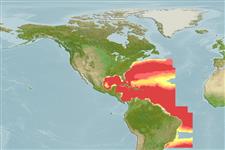Environment: milieu / climate zone / depth range / distribution range
Ecologie
marien; oceanodroom (Ref. 51243); diepte 50 - ? m. Tropical; 20°C - ? (Ref. 168); 43°N - 28°S, 100°W - 26°W (Ref. 55290)
Western Atlantic: off Martha's Vineyard, Massachusetts south to Trinidad Island and Rio de Janeiro, Brazil (Ref. 168); including south of Brazil (Ref. 36453). Highly migratory.
Lengte bij maturiteit / Grootte / Gewicht / Leeftijd
Maturity: Lm 49.4 range ? - ? cm
Max length : 108 cm FL mannelijk / geslacht onbekend; (Ref. 40637); common length : 72.0 cm FL mannelijk / geslacht onbekend; (Ref. 168); max. gepubliceerd gewicht: 20.6 kg (Ref. 40637)
Dorsale stekels (totaal): 13; Dorsale zachte stralen (totaal): 14-15; Anale stekels 0; Anale zachte stralen: 13 - 14; Wervels: 39
Found in oceanic waters, sometimes not far from the coast (Ref. 13628). Forms large mixed schools with the skipjack tuna. Its spawning grounds are located well offshore. Preys on surface and deep-sea fishes, squids, amphipods, shrimps, crabs and stomatopods and decapod larvae. The largest fishery for blackfin tuna operates off the southeastern coast of Cuba and uses live-bait and pole. Utilized fresh, dried or salted, canned and frozen (Ref. 9987).
Levenscyclus en paargedrag
Maturiteit | Voortplanting | Paaien | Eieren | Fecunditeit | Larven
Collette, B.B. and C.E. Nauen, 1983. FAO Species Catalogue. Vol. 2. Scombrids of the world. An annotated and illustrated catalogue of tunas, mackerels, bonitos and related species known to date. Rome: FAO. FAO Fish. Synop. 125(2):137 p. (Ref. 168)
Status op de Rode Lijst van het IUCN (Ref. 130435)
Gevaar voor de mens
Harmless
Gebruik door de mens
Visserij: commercieel; sportvis: ja
Tools
Speciale rapporten
Download XML
Internetbronnen
Estimates based on models
Preferred temperature (Ref.
123201): 10 - 20.5, mean 14.4 °C (based on 163 cells).
Fylogenetische diversiteitsindex (Ref.
82804): PD
50 = 0.5039 [Uniqueness, from 0.5 = low to 2.0 = high].
Bayesian length-weight: a=0.01148 (0.00699 - 0.01886), b=3.05 (2.91 - 3.19), in cm total length, based on LWR estimates for this species & Genus-body shape (Ref.
93245).
Trofisch niveau (Ref.
69278): 4.4 ±0.3 se; based on diet studies.
Weerstandsvermogen (Ref.
120179): Gemiddeld, minimale populatieverdubbelingstijd 1,4-4,4 jaar (K=0.22; tm=3; tmax=5).
Prior r = 0.77, 95% CL = 0.51 - 1.16, Based on 1 stock assessment.
Fishing Vulnerability (Ref.
59153): High vulnerability (61 of 100).
Climate Vulnerability (Ref.
125649): High to very high vulnerability (75 of 100).
Nutrients (Ref.
124155): Calcium = 48.4 [26.7, 111.0] mg/100g; Iron = 2.86 [1.11, 6.97] mg/100g; Protein = 22.9 [21.4, 24.3] %; Omega3 = 0.31 [0.19, 0.52] g/100g; Selenium = 84.5 [27.1, 268.2] μg/100g; VitaminA = 69.2 [9.8, 534.2] μg/100g; Zinc = 0.59 [0.31, 1.14] mg/100g (wet weight);
